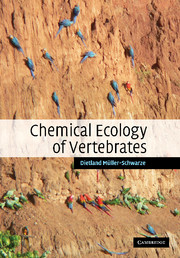Book contents
- Frontmatter
- Contents
- Preface
- Acknowledgements
- 1 The odorsphere: the environment for transmission of chemical signals
- 2 Properties of vertebrate semiochemicals
- 3 Odor production and release
- 4 Chemical cues in orientation and navigation
- 5 Chemoreception
- 6 Signaling pheromones I: discrimination and recognition
- 7 Signaling pheromones II: sex and alarm pheromones and evolutionary considerations
- 8 Intraspecific signals: priming pheromones
- 9 Development of intra- and interspecific chemical communication
- 10 Allomones I: chemical defense by animals
- 11 Allomones II: plant chemical defenses against herbivores
- 12 Kairomones and synomones
- 13 Practical applications of semiochemicals
- Glosssary
- References
- Index
1 - The odorsphere: the environment for transmission of chemical signals
Published online by Cambridge University Press: 23 November 2009
- Frontmatter
- Contents
- Preface
- Acknowledgements
- 1 The odorsphere: the environment for transmission of chemical signals
- 2 Properties of vertebrate semiochemicals
- 3 Odor production and release
- 4 Chemical cues in orientation and navigation
- 5 Chemoreception
- 6 Signaling pheromones I: discrimination and recognition
- 7 Signaling pheromones II: sex and alarm pheromones and evolutionary considerations
- 8 Intraspecific signals: priming pheromones
- 9 Development of intra- and interspecific chemical communication
- 10 Allomones I: chemical defense by animals
- 11 Allomones II: plant chemical defenses against herbivores
- 12 Kairomones and synomones
- 13 Practical applications of semiochemicals
- Glosssary
- References
- Index
Summary
The scent of flowers does not go against the wind, not sandal, rosebay or jasmine, but the scent of the good goes against the wind; a good man is wafted to all quarters.
suttapitaka (“basket of discourse”), from Pali canon of Theravada Buddhists, ca. 500–250 BCLand animals exploit the odorsphere, the world of vapors around them. In any given locale, they move in an odorscape, a landscape of volatiles. Even in fish we speak of odors because neurophysiologically the olfactory system is involved, even though water-soluble stimulants are not necessarily volatile. We expect vertebrates to have taken advantage evolutionarily of the physicochemical characteristics of their environment first to select and then to optimize chemical communication. The chemical communication system of a cold-water fish differs vastly from that of a tropical bat. Despite similar biological functions, each system has been shaped by, and is adapted to, a distinct set of environmental circumstances.
In air, temperature, relative humidity, barometric pressure, and air currents not only modulate the movement of molecules from the source but also affect odor reception once the molecules have arrived near the receptors. The evaporation of an odor from a surface such as animal skin, a scent mark, or vegetation is regulated by air temperature, relative humidity, the porosity of the surface, and other compounds present (Regnier and Goodwin, 1977; Figs. 1.1 and 1.2).
The evolution of chemical communication was probably influenced by such additional factors as adsorption of aerial pheromones to vegetation, or waterborne pheromones to suspended clay. The influence of these environmental features has very likely selected for both the choice of chemical constituents of the signals and the appropriate signal-emission behaviors (Gleeson, 1978).
- Type
- Chapter
- Information
- Chemical Ecology of Vertebrates , pp. 1 - 19Publisher: Cambridge University PressPrint publication year: 2006
- 1
- Cited by



